A Business of Her Own: Jewish Women Entrepreneurs of the Past
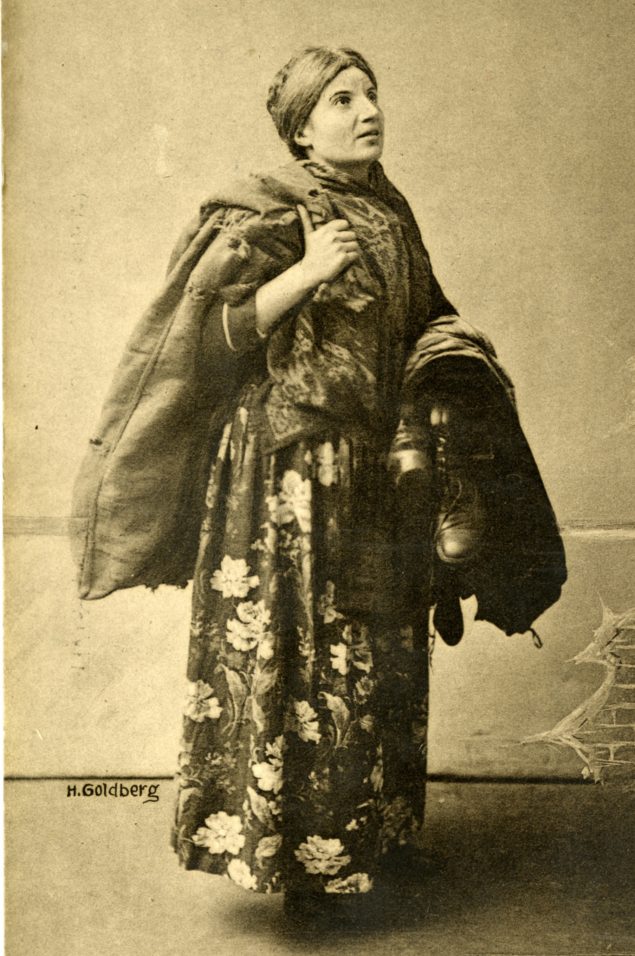
Postcard depicting a Jewish woman, a buyer of secondhand clothing. From the Archives of the YIVO Institute for Jewish Research, New York
By Faigy Grunfeld
Close your eyes and envision the quintessential Jewish woman of centuries past. Perhaps she is stirring a pot that hangs over a fire while singing a Yiddish folksong to her young daughters. Maybe she is rolling pastry dough while urging her boys to get to cheder. Or perhaps she is haggling with vendors at the marketplace, triumphantly brandishing her purchases after securing a sound price. But while the quintessential Jewish woman of the past most likely did stir pots, roll pastry dough and haggle with vendors, she was also a formidable force in the business world.
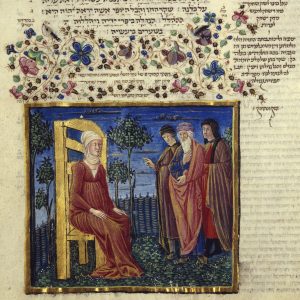
Illuminated page from the Rothschild Miscellany of Sefer Mishlei, showing the “Woman of Valor” as the mistress of the house, giving counsel to her husband and sons. The Miscellany is a collection of illuminated texts from Veneto, Northern Italy, circa 1460-80, housed at the Israel Museum in Jerusalem. Photo: Bridgeman Images
Medieval Professions
In Talmudic times, women contributed to their household incomes mostly through spinning and weaving, which were important ancient industries; some sought out extra income by serving as a “wailing woman” at funerals. However, the medieval Jewish woman was a truly impressive commercialist.
Christianity condemned usury because of the Biblical prohibition: “Thou shalt not lend upon interest to thy brother” (Deuteronomy 23:20); however, as Jews and Christians were not considered “brothers,” many Jews took on the role of moneylenders. Because of their connections to Jewish communities around the globe, they were able to access significant funds, and often became indispensable to many princes and nobles.
French women like Minna of Worms (eleventh century) and Pulcellina of Blois (twelfth century) were savvy moneylenders and extended services to the nobility in their regions.1 In thirteenth-century England, Licoricia of Winchester dominated the profession, with her name appearing in many business documents along with those of nobles and monasteries. However, the majority of Jewish women who were moneylenders conducted small-scale transactions with their local Christian neighbors.
Women were also successful traders, reflected in travel documents and business inventories. While the most common profession for women was textile production—weaving and embroidery—women were also land-renters and conducted large-scale business transactions, and often appeared in beit din, as evident from various documents.2
 Farming was another popular profession—at least until the Middle Ages. Jews had been involved in agriculture from Talmudic times until twelfth and thirteenth-century medieval Europe, when they were barred from owning land. One letter, preserved in the She’eilot u’Teshuvot of the Maharam, a medieval Tosafist, highlights the hardships of a particular widow who worked as a farmer. Detailing the travails of the woman, the letter asks that the Jewish community lower communal taxes.
Farming was another popular profession—at least until the Middle Ages. Jews had been involved in agriculture from Talmudic times until twelfth and thirteenth-century medieval Europe, when they were barred from owning land. One letter, preserved in the She’eilot u’Teshuvot of the Maharam, a medieval Tosafist, highlights the hardships of a particular widow who worked as a farmer. Detailing the travails of the woman, the letter asks that the Jewish community lower communal taxes.
She sweats a lot and eats little. Sometimes the fruit is burnt or becomes decayed or injured . . . the sharecroppers take half the profit. Sometimes there are reverses, such as too much sun or too much cold, too little rain or too much rain, or hail or several kinds of locusts.3
Jewish men and women were barred from medieval universities, and therefore had no opportunity to earn a doctorate in medicine (medieval universities awarded these rare degrees after over a decade of study). Many therefore learned the art of healing through apprenticeship. In Frankfurt during the 1420s and 1430s, there were seven Jewish female doctors, four of whom were ophthalmologists. One Yehuda ben Asher records his near blindness and subsequent treatment in his ethical will:
Then a Jewess, a skilled oculist, appeared on the scene. She treated me for about two months and then died. Had she lived another month, I might have recovered my sight fully. As it was, but for the two months’ attention from her, I might never have been able to see at all.4
City records indicate there were Jewish female doctors practicing in thirteenth-century Paris, as well as in fourteenth-century Aragon, where one particular Jewess, Floreta Ca Noga, even treated the queen of Spain.
Was the “working woman” a widespread personality or was she a rare phenomenon?
Evidence of a strong female presence in the workforce is found in the Jewish cannon itself. Medieval rabbinic authorities dealt with a plethora of questions related to female finances. Societal shifts during that period led rabbinic authorities to adjust previous restrictions relating to women doing business with gentiles, swearing in court, traveling alone, and compensating for damages and other liability issues. Rabbi Eliezer ben Natan of Mainz (the Raban, twelfth century), took a more permissive stance than his contemporaries regarding female autonomy in business matters, as indicated in his work, Even HaEzer, section 115:
In these days women are legal guardians and vendors and dealers and lenders and borrowers, and they pay and withdraw and collect and deposit money, and if we say they cannot swear or affirm their business negotiations, then you will forsake these women and people will begin to avoid doing business with them.
In many communities, certain professions were reserved for the rabbi’s wife so she could contribute to the family’s earnings beyond the small rabbinic stipend. Her jobs included making Havdalah candles, weaving tzitzit, manufacturing parchment used for Torah scrolls, tefillin and mezuzot, and embroidering curtains for the Torah ark.
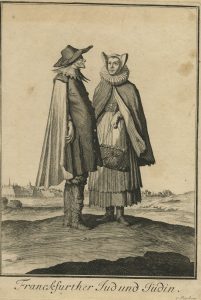
Print of a Jewish couple in Frankfurt am Main, 1703, dressed in everyday garb, possibly on the way home from the market. From the Leo Baeck Institute, New York
Businesswomen in the Early Modern Era (1500-1750)
By the early modern period, women’s businesses were evolving. After a series of expulsions and crusade attacks, Ashkenazic Jewry slowly began to move to Central and Eastern Europe, burrowing roots in Poland and Lithuania. In this environment, women were again critical to the financial infrastructure.
Raszka Fishel was a banker, and so indispensable to the Polish court that when the Jews of Cracow were expelled in 1495, Raszka was the only one allowed to remain in the city by order of King Jan Olbracht.5
Raszka was a formidable businesswoman. The men in her family were scholars and mystics, while she dealt with the more practical aspects of life. She acted as lady-in-waiting to the Queen Mother, and convinced the king to use her silver to produce coins in royal mint (and she finagled a fabulous rate for her silver). She secured for her son the post of tax collector for the king, and for her son-in-law, the position of chief rabbi of Poland. Through these appointments, the Fishel family came to dominate many avenues of power in Poland.6
Eventually, poverty in Poland caused Jews to shift from being moneylenders to money borrowers, so that usury was no longer a realistic profession for Polish Jewry. Industrious women became tavern-keepers or inn-keepers. Indeed, the memorable zydowka (Jewess) who ran the karczma (tavern) has a nostalgic grip on our imaginations. Her responsibilities, including serving, feeding and housing travelers and visitors, seemed to suit her maternal nature, for she filled this role more successfully than her husband.7
There were also cheese-makers, goose-herders, washerwomen and the poorest of the lot—market vendors. Testifying to the presence of Jewish women in the workforce, the latter profession gave rise to the halachic question regarding women wearing men’s winter coats. During those long market days, female vendors were vulnerable to the bitter cold of Eastern European winters. Despite the prohibition against cross-dressing, Rabbi Yoel Sirkis (the Bach, seventeenth century), permitted women to wear the warmer men’s coats.8
Most women involved in commerce had to hustle to make a living, acting as hawkers, stand-owners or wholesalers. Occasionally women were highly successful, as was the case for seventeenth-century Gitl Kozuchowski from Poland who, along with her husband, built a flourishing commercial house. Her husband outlined her role in his will:
She is to deal in all business that there is according to her desire and will . . . because she is the lady of the house, dominant and ruling over the entire estate and business for all of her days.9
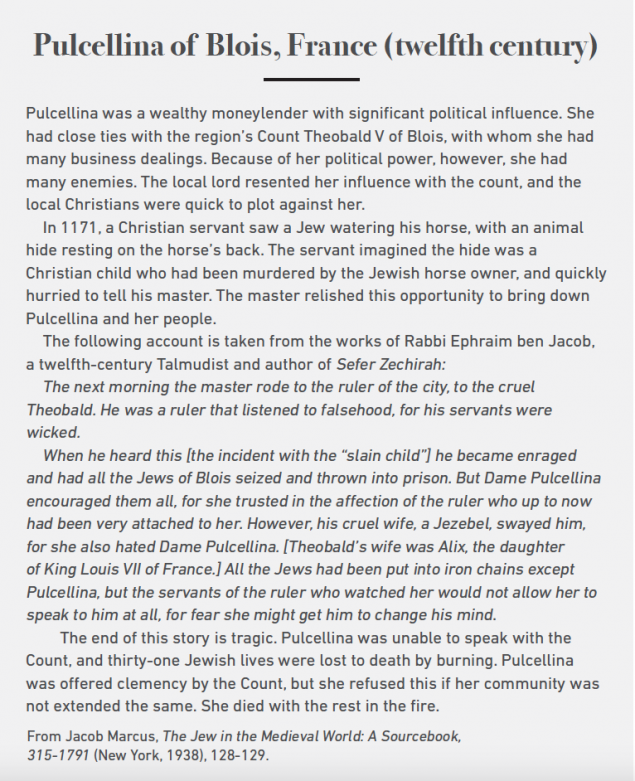 The Widowed Woman
The Widowed Woman
Widowed women had no choice but to be financially active. Glückel of Hameln’s memoir outlines some of her business dealings as a widow.
I was busied in the merchandise trade, selling every month to the amount of five or six hundred Reichstalers. Besides this, I went twice a year to the Brunswick Fair and each time made my several thousands profit.10
The widow’s finances certainly deteriorated once she entered this new status, evidence that both men and women were necessary for a household’s financial stability.
 Shtetl Life (1750-1940)
Shtetl Life (1750-1940)
The Eastern European shtetl11 conjurs up an image of an idyllic world marked by milkmen and water-carriers, bustling marketplaces and cozy wooden homes. But the nostalgia for the simplicity of shtetl life overlooks the unrelenting hardships, extreme poverty and overt anti-Semitism that was part and parcel of shtetl life.
Against this backdrop, the shtetl wife was electric, alive, in motion. The shtetl mother was up by 3:00 am and went to bed long after her children. Strong, shrewd, capable and always employed with some task, she defined vitality and grit, and was both affectionately and warily referred to as a “Cossack.”12 Many writers reflecting on life in the shtetl recall that they never saw their mothers sleep.
Wives of scholars had to assume the responsibilities of daily life, for their husbands had little experience with paying taxes, tending the vegetables or shoveling snow. This reality prompted many women to say knowingly, “As for Olam Haba, let the men say we can’t get there without them. They couldn’t manage this life alone, no doubt we will have to do the job for them there too.”13
Female productivity in the workforce was so vital, in fact, that when researching a shidduch, many parents would look for a girl who spoke Polish, so she could conduct business with the locals. In some shidduch letters between Rabbi Shmuel of Kelm and his nephew, a prospective girl is described as “educated in reading Hebrew, Polish, German . . . and also the Russian alphabet is not unfamiliar to her.”14
Although unmarried girls were usually absorbed with household chores and helping with the younger children, some instances show these young women working towards their own dowry, as in the case of Rabbi Simcha Zissel Ziv of Kelm’s daughter, who simultaneously earned her dowry and aided her parents with their finances by running a shop.15 Girls without a dowry or financial stability worked as household servants in wealthy Jewish homes, and after a few years saved up enough to finance their own shidduch.
By the nineteenth century, shopkeeping became one of the most widespread occupations for women, especially for wives of Torah scholars in nineteenth-century Lithuania. Rabbi Naftali Amsterdam’s wife ran a bakery, Rabbi Meyer Yonah Barentski’s wife was a merchant and the wife of Rabbi Aderet of Ponovezh managed a dry-goods shop. Many heartfelt letters reflect the anguish of rabbinic scholars who often traveled to other towns for study, leaving their wives to shoulder a multitude of responsibilities, including the children, the business and aging parents.
In early twentieth-century America, industrial growth and financial success made it so that women were no longer critical to the family’s earnings. Ironically, these economic and societal improvements actually created a stigma against women who did work. (This reality paved the way for the second wave feminism in the 1960s, which fought for financial independence for women.) So while many of our mothers and grandmothers may have been stay-at-home-moms, it is very probable that our great- and great-great grandmothers were industrious businesswomen.
Over the millennia, the Jewish woman has drawn upon her many talents, skills and resources to confront a myriad of challenges—be they physical, spiritual or financial. When necessary, she valiantly joined the workforce, adding new responsibilities to her tiringly long list, personifying Rashi’s assertion that women can simultaneously “tend the vegetables, spin flax, teach a woman a song for a fee and warm the silkworms.”16 With remarkable inner strength, tenacity and faith, the Jewish woman occupied her various roles of homemaker, mother, wife, daughter, breadwinner, supporter and caretaker while managing to raise generations of God-fearing and righteous Jewish sons and daughters.
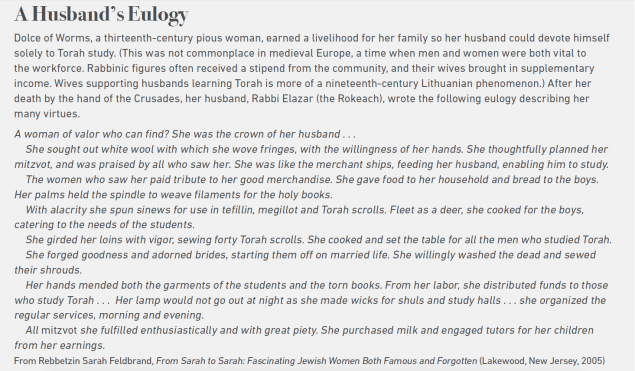 Notes
Notes
1. Baumgarten, Elisheva, “Medieval Ashkenaz (1096-1348),” Jewish Women: A Comprehensive Historical Encyclopedia, 1 March 2009, Jewish Women’s Archive, https://jwa.org/encyclopedia/article/medieval-ashkenaz-1096-1348.
2. Judith R. Baskin, “Jewish Women in the Middle Ages,” Jewish Women in Historical Perspective, Second Edition, ed. Judith R. Baskin (Detroit, 1998), 105-110.
3. Emily Taitz, et al., The JPS Guide to Jewish Women (Philadelphia, 2003), 87.
4. Israel Abrahams, trans., Hebrew Ethical Wills, Second Edition (Philadelphia, 1976), 165-166.
5. Rosman, Moshe, “Poland: Early Modern (1500-1795),” Jewish Women: A Comprehensive Historical Encyclopedia, 1 March 2009, Jewish Women’s Archive, https://jwa.org/ encyclopedia/article/poland-early-modern-1500-1795.
6. Byron L. Sherwin, Sparks Amidst the Ashes: The Spiritual Legacy of Polish Jewry (New York, 1997), 62-67.
7. Rosman, “Poland: Early Modern (1500-1795).”
8. Bach commentary on the Tur, YD 182.
9. Rosman, “Poland: Early Modern (1500-1795).”
10. The Memoirs of Glückel of Hameln, trans. Marvin Lowenthal (New York, 1960), 179.
11. This article focuses on the classical trajectory of Ashkenazic Jewry; however, there is a rich history of women in Western Europe, the Muslim Empire (Sephardic), Italy, America and Israel, which is beyond the scope of this article.
12. Menachem Brayer, The Jewish Woman in Rabbinic Literature, vol. 2 (Hoboken, 1986), 57.
13. Ibid., 52
14. Immanuel Etkes, “Marriage and Torah Study Among the Lomdim of Lithuania,” The Jewish Family: Metaphor and Memory (New York, 1989), 166.
15. Ibid., 169.
16. Rashi, Ketubot 66a.
Faigy Grunfeld teaches English and history. She lives in Detroit, Michigan with her family
